Upgrading the SSD in Chromebook & MyDigitalSSD Super Boot Drive M.2 2242 SSD Review
by Kristian Vättö on October 21, 2014 8:00 AM ESTThe Upgrade
Upgrading the storage in the Acer C720 Chromebook is surprisingly easy. While Chrome OS does not give the user full system access, there is an integrated (albeit hidden) tool for creating recovery media that can be used to clone the old drive. To open the tool, all you need to do is to open Chrome (i.e. the web browser) and type "chrome://imageburner" to the address bar. Once you have done that, you should see the following:
To create the recovery media, you need either a USB drive or an SD card (minimum 4GB). The tool will not just clone your existing drive but will in fact download the OS again, which in my case was a 498MB download. The downloaded file is then extracted to the USB drive to create the bootable recovery media.
Alternatively, you can also create the recovery media using another computer. Google offers a tool for both Windows and OS X, which can be found here along with the instructions. I tried this as well on my Mac Pro and did not encounter any issues.
After successfully creating the recovery media, you can begin the actual upgrade, which starts by removing the 13 screws on the bottom of the laptop.
Note that at least in the case of the Acer C720, the warranty is (in theory) void if you remove the back cover. That is unfortunate, but on the other hand Chromebooks have not been designed to be user upgradeable.
This is what the internals of the C720 look like. The SSD is located on the right-hand side right above the speaker, so upgrading it does not involve any further disassembly.
The C720 ships with a 16GB Kingston SSD that is held in place by a single screw. Simply remove the screw and the SSD will come out of its socket.
The Kingston SSD is also Phison S9 based and has a single 16GB NAND package with Kingston markings on it. I apologize for the unclear package markings – the label left residue on the packages, which made the markings practically invisible. Anyway, Kingston has not published any NAND data sheets so the markings would not give us many details in the first place. I would make an educated guess that the NAND package has two 64Gbit dies in it from either Micron or Toshiba.
Installing the new SSD is as easy as removing the old one and the assembly process also follows the same instructions as the disassembly, just in the opposite order.
With the new SSD installed, you need to boot with the USB drive or SD card attached for the recovery process to start. Otherwise you will be presented a message that says no OS found and asks you to insert the recovery media or create one using another computer.
The recovery process itself only takes about 15 minutes, so the whole upgrade process should take around half an hour or so. Once the recovery process is complete, the system will be ready for use. The nice thing about Chrome OS is that because it is cloud based, signing in to your Google account will basically restore all settings that you had in place previously, so you can continue from where you were before the upgrade.


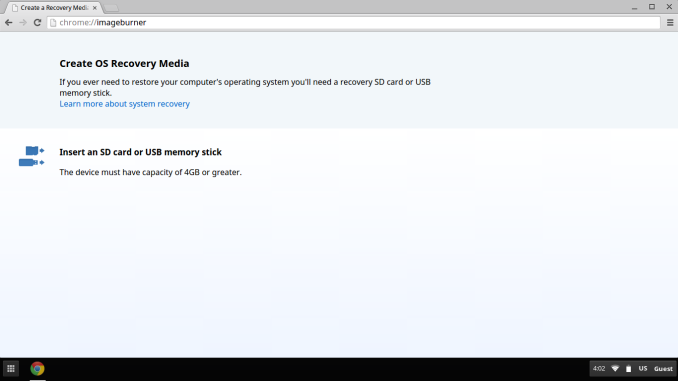

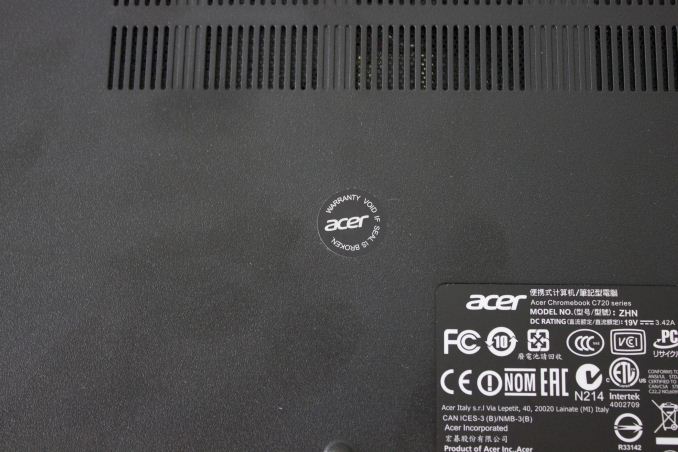
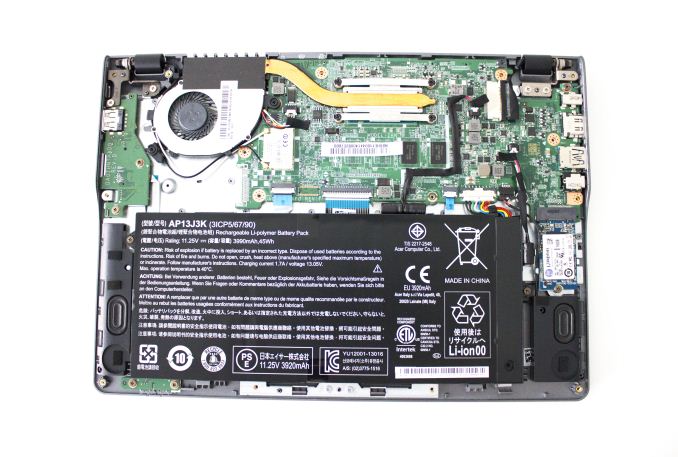
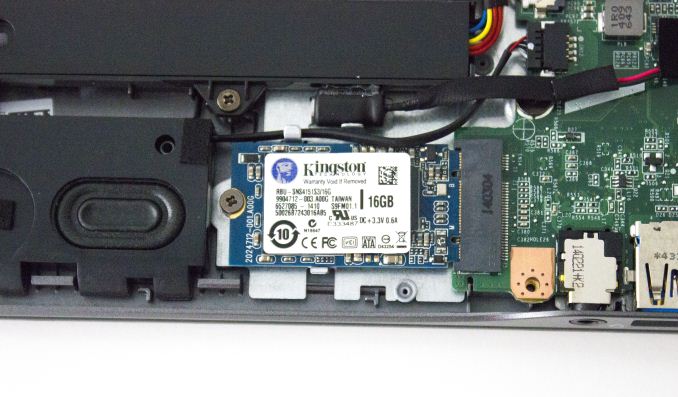
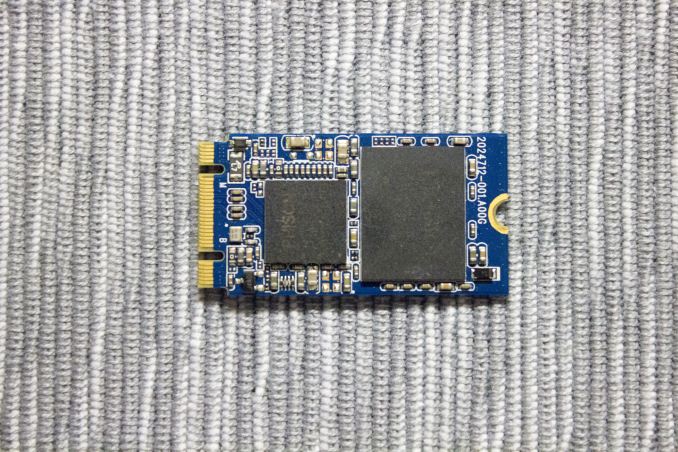
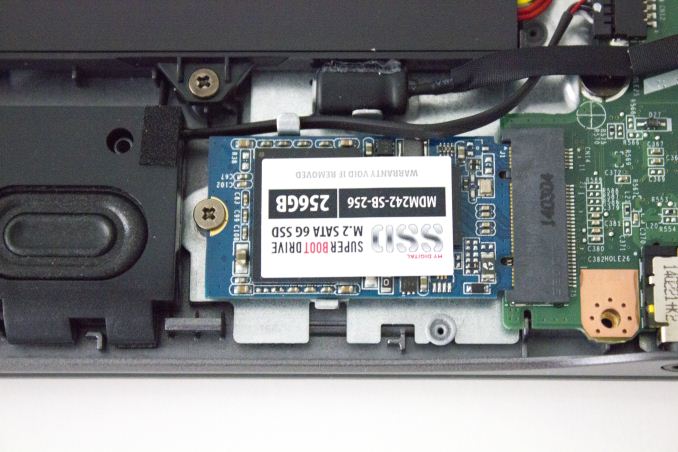








67 Comments
View All Comments
Alexstarfire - Friday, October 24, 2014 - link
I remember the keyboard and screen resolution being the two biggest drawbacks for me. With the size of the netbooks there really wasn't/isn't a way for them to do much about the keyboard problem. My hands are simply took big for a standard keyboard on a 10" platform.The resolution was something they potentially could have fixed, at a cost. I couldn't fit enough on the screen to make it worthwhile for me.
On the other hand, the netbook wasn't for me but for my GF at the time and she had smaller hands than mine. She didn't really find any issues with the netbook other than the 1 time or so we actually needed an optical drive. Fortunately I had an external drive.
xamigax - Monday, January 19, 2015 - link
I own the C720 (without "p", hence no touchscreen), 2Gb ram 16Gb SSD, and Haswell architecture.It's small, light, has a very decent autonomy (>6hours, nothing optimized yet) and is surprisingly fast, thanks to Haswell chipset.
I dumped ChromeOS and installed a regular Ubuntu 14.10 (only "tweak" so far: update kernel to 3.17.3-031703-generic so touchpad is included), it's quite a fantastic machine for the price.
I do love this enough to be seriously considering buying a bigger SSD (128Gb should be perfect) to be able to download all my raw photos onto it before working on them with darktable / rawtherapy / ...
This should become a wonderfull portable studio!
The 2Gb RAM C720 was available for 199$.
128Gb ssd M.2 type 2242 can be found near 70$.
I can't think of any windows based model that might not get totally humiliated in such price range.
WithoutWeakness - Tuesday, October 21, 2014 - link
Not only were SSD's much more expensive 4 years ago but Windows 7 on a 16GB drive would be a nightmare to try and market. I know it can be done with compression but there would be next to no free space. Chrome OS can get away with it because all the apps are tiny little browser extensions and users are conditioned to store next to nothing locally. Windows users expect local storage with enough space to install full-blown 1GB+ software packages and hold all of their media. Netbooks were initially created and marketed as a small, portable web machine that could run some programs if needed but a lot of people just bought them because they saw them as $200-$300 Windows laptops.pSupaNova - Tuesday, October 21, 2014 - link
Microsoft's Windows was not on the first Netbooks, they had a flavour of linux on them. So no Microsoft was not ahead of their time they scrambled to put their bloated OS on these machines and ended up killing them.Chrome OS is here to stay because it easy to use and maintain. Windows 10 has not got a chance on these form factors it fuzzy and tries to do to much when the world is quickly moving to SAAS model.
LostAlone - Tuesday, October 21, 2014 - link
But no-one bought the Linux netbooks. Geeks who get what linux is did a little bit, but not the general public. If you are a normal human being, what possible reason would you have for getting a linux-anything?It wasn't until September of 2014 that you could watch Netflix natively on Linux. And even today it still takes a hack to actually work. These kinds of problems exist in droves, and of course that's part of the downside of Linux being free and open, but if you are a consumer all you care about is if you can watch Netflix or not.
MS didn't somehow bully linux off of netbooks. Microsoft wasn't even involved. OEMs took stock Vista and put it on very underpowered hardware. Off course the results were bad. But it was never Microsoft's fault. It was Dell and Packard Bell and Acer and all the others who put Vista on very low end hardware.
It wasn't until recently that Microsoft actually got more directly involved in how their OS is used, and as a result we ended up with Windows RT, a slimmed down OS designed for lower powered devices, and specifically for ARM chips that dominate the market in tablets. Once MS actually got involved they did a great job.
Chrome is a great OS, essentially because it tries to make it so users don't ever need to deal with the operating system, just a browser that they are already familiar with. That's the reason why it's had any success at all. But Windows 10 is going come, and it is going to be aggressively pushed, and with today's low powered chips, the faster speed of storage and the greater amounts of RAM, it's going to perform really well and people are going to buy it because it's familiar to them.
And for the record - It doesn't matter if the world moves totally to SAAS (good luck making games work like that ;) ) people will still need an operating system on their PC, and they are still going to stick with Windows because it's what they know, and likely what they have used for years. SAAS will never change that the vast majority of personal machines in the world will run windows for the forseeable future. Not even OSX's rise from the ashes as the coolest, hippest, sexiest OS has significantly changed that. Windows is here to stay.
tuxRoller - Wednesday, October 22, 2014 - link
"that's part of the downside of Linux being free and open"Citation, please.
LostAlone - Thursday, October 23, 2014 - link
Are you saying that Linux's driver support is equal to windows? I think that's something that needs a damn citation.jejones3141 - Saturday, December 20, 2014 - link
My experience buying a netbook makes me think that someone was flat out intentionally making Linux look bad. Here's my story:I bought an Asus Eee 900A at Best Buy. 32-bit Atom CPU, tiny but usable keyboard, 1 GB RAM... and, I am not making this up, a 4 GB SSD with Xandros Linux installed on it using UnionFS. UnionFS makes it easy to drop back to the initial factory configuration, but takes up quite a bit of space for that read-only partition with the factory configuration on it. I took it home, fired it up, it announced that there were a dozen packages with upgrades--sure, download and install them. Before it finished downloading them, the SSD was full and the netbook hung.
I was lucky--I knew that the thing to do was wipe that read-only partition and install what was then eee Linux, later on easy peasy Linux. Worked like a charm, and later on I got a bigger SSD, maxed it out with 2 GB of RAM, and moved to Bodhi Linux. Still works fine; I'll find it a good home once my C720 arrives (and I'll upgrade its SSD and set up to dual boot ChromeOS or Linux)...
...but here would be the more common scenario: Joe Average--no, Grandpa Average--sees an inexpensive computer to get his grandchild for Christmas, buys Eee 900A. The big day arrives, the kid tears open the box, starts it up. "There are a dozen packages that have upgrades." Sure, upgrade them... and the SSD fills up, the computer hangs, and the grandchild throws a tantrum. At the crack of dawn on December 26th, Grandpa Average is pounding on the Best Buy door demanding satisfaction, and I'm sure the salesperson was happy to blame Linux for the problem and upsell Grandpa Average to a far more expensive laptop running Windows.
I can't believe that kind of misconfiguration was unintentional; someone made sure that people who dared run Linux would have a bad experience.
rahvin - Tuesday, October 21, 2014 - link
Microsoft actively killed the netbook. They placed heavy restrictions on the hardware and software allowed to be included through their OEM contracts. For example, netbooks weren't allowed to be installed on anything but ATOM processors, they were limited to IIRC 1 gig of ram, etc. Even stuff like hard drive size was limited. Microsoft didn't want netbooks to succeed because they would have eroded their margins.Thankfully Google has no such concerns and has happily eroded the entire PC market pricing. Microsoft's hubris cost them significant market share with chromebooks now occupying the 3-4 of the top five sales spots on Amazon, consistently every month. Even Dell, who is adamantly Microsoft and Intel, has announced their intent to produce a chromebook because chromebooks are now major sellers. Hopefully chromebooks will continue to be successful.
Michael Bay - Wednesday, October 22, 2014 - link
Your bias is laughable. At least use your beloved google to learn who defined the category first.And how do you even "install" netbook ON to something?